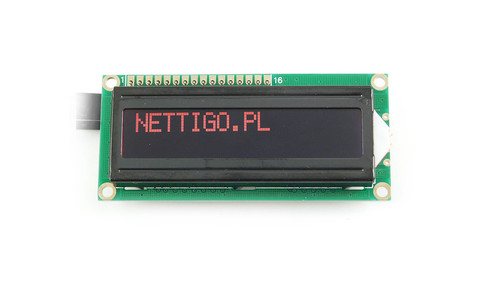Recently added
More...Categories
Suppliers
Newsletter
Once, twice in month we will send You info about new products, products on sale and news from Arduino and DIY world.
LCD 2x16 ruby

LCD 2x16 ruby, driver compatible with HD44780. Ruby characters on black background. Ultimate retro vibe!
On stock:
 13
13

LCD Display 2x16 Characters Black/Ruby
Atmospheric 2x16 character display with red characters on a black background. Reliable and, most importantly, easy to use. It can display two lines of 16 characters each. Built based on an HD44780-compatible controller, which practically means it is supported by the LiquidCrystal library in Arduino.
We also offer other colors of 2x16 character displays. Standard connection of the display requires at least 6 GPIO ports, so a good alternative is to use an I2C converter. Then, only 2 I2C bus GPIOs are needed for connection.
Specification:
- Supply voltage: 5V
- Display current consumption: 2 - 3 mA
- Backlight current consumption: 120mA
- Type: character LCD
- Number of characters: 2x16
- Controller: compatible with Hitachi HD44780
- Background color: black
- Character color: red / ruby
- Display board size: 80 x 36 mm
- Mounting hole spacing: 75 x 31 mm
- Mounting hole diameter: 3 mm
- Character size: 2.45 x 5.00 mm
- Operating temperature: from -20C to +70C
Pinout:

| Pin | Function | Description | Remarks | |
| – | – | :—- | :– | |
| 1 | VSS | Ground | ||
| 2 | VDD | Power supply | +5V | |
| 3 | V0 | Contrast | ||
| 4 | RS | Register select | LOW - instruction registerHIGH - data register |
|
| 5 | RW | Read/write mode | LOW - readHIGH - write |
|
| 6 | E | Enable - enables writing to registers | ||
| 7 | DB0 | Data bus | ||
| 8 | DB1 | Data bus | ||
| 9 | DB2 | Data bus | ||
| 10 | DB3 | Data bus | ||
| 11 | DB4 | Data bus | ||
| 12 | DB5 | Data bus | ||
| 13 | DB6 | Data bus | ||
| 14 | DB7 | Data bus | ||
| 15 | A | Backlight power | +5V | |
| 16 | K | Backlight ground |
Control and connection:
The display is supported by the LiquidCrystal library in Arduino.
A display based on HD44780 can be controlled in several different ways:
- Using 6 GPIOs in 4-bit mode without reading the busy flag. 4 data bus lines (D4-D7) and two control lines RS and E are used, while RW is connected to ground.
- Using 7 GPIOs in 4-bit mode with busy flag reading. 4 data bus lines (D4-D7) and three control lines RS, E, and RW are used.
- Using 10 GPIOs in 8-bit mode without reading the busy flag. 8 data bus lines (DB0-DB7) and two control lines RS and E are used, while RW is connected to ground.
- Using 11 GPIOs in 8-bit mode with busy flag reading. 8 data bus lines (DB0-DB7) and three control lines RS, E, and RW are used.
We most often use the first method - 4-bit mode without reading the busy flag. This method saves microcontroller GPIOs. It does require using additional software delays (to avoid reading the busy flag), but in most cases, this does not pose additional problems.
And wherever we have the I2C (TWI) protocol available, we use displays with I2C converter. After all, it requires 4 fewer GPIOs for connection.
Wyświetlacze znakowe (interfejs równoległy):









Wyświetlacze LCD I2C / SPI:









Akcesoria i moduły:



Recently added
More...Categories
Suppliers
Newsletter
Once, twice in month we will send You info about new products, products on sale and news from Arduino and DIY world.














